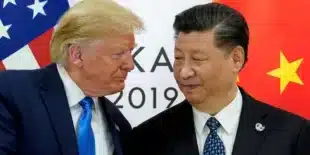As president, Donald Trump imposed a 25% tariff on foreign steel, which negatively impacted Clips & Clamps Industries, a Michigan auto supplier, by raising material costs, making it harder to compete with overseas rivals, and costing several contracts.
Company president Jeff Aznavorian had hoped for relief with Joe Biden’s administration but was surprised when Biden largely maintained Trump’s tariffs on steel, aluminum, and a wide range of Chinese goods.
“It was unexpected that a different administration would keep these policies,” Aznavorian noted, contrasting Biden’s approach with that of former Democratic President Bill Clinton, who advocated for freer trade. “This is very different from what we anticipated from the Biden administration.”
Trump and Biden differ on many issues like taxes, climate change, immigration, and regulation. However, they share a similar stance on trade policy. Regardless of who wins the presidency, the U.S. appears set to continue a protectionist trade policy, which experts warn could contribute to inflation pressures.
Last week, Biden announced new tariffs on Chinese electric vehicles, advanced batteries, solar cells, and other products to prevent Beijing from flooding the U.S. with cheap imports.
The protectionist leanings of both presidential contenders reflect a broad view that increasing imports, particularly from China, has hurt American manufacturing jobs and closed factories. This issue is especially significant in Midwestern industrial states critical to the presidential election.
William Reinsch, a former trade official now at the Center for Strategic and International Studies, said, “Trade will play a significant role in key states like Pennsylvania, Michigan, and Wisconsin.”
Both candidates have moved away from a long-standing U.S. commitment to relatively open trade with minimal government interference, a policy that had been a cornerstone of American strategy since World War II. This approach was believed to reduce costs and benefit consumers and businesses globally.
However, over recent years, the perception has grown that while free trade benefits households and companies, it has harmed workers by offshoring American jobs to countries with cheaper labor.
Robert Lighthizer, Trump’s chief trade negotiator, wrote in his 2023 book, “No Trade Is Free,” that the once nearly unanimous consensus on free trade in Washington is dead.
Like free trade, protectionism has its downsides. It can increase costs for households and businesses, support inefficient companies, provoke retaliatory tariffs from other countries, and strain relationships with both allies and adversaries.
Trump, who proudly called himself “Tariff Man,” imposed import taxes to reduce trade deficits, especially with China. He renegotiated the North American trade deal and pressured China to buy more American agricultural products. Despite these efforts, U.S. manufacturing jobs did not increase, and trade deficits remained.
In a potential second term, Trump has threatened to impose a 10% tariff on all imports and a 60% tax on Chinese goods, which Mark Zandi, chief economist at Moody’s Analytics, warns would lead to higher inflation, reduced GDP, fewer jobs, and increased unemployment.
Zandi estimates that a year after imposing such tariffs, consumer prices would be 0.7 percentage points higher. A report from Kimberly Clausing and Mary Lovely of the Peterson Institute for International Economics suggests Trump’s tariff proposals would effectively be a $1,700 annual tax for middle-income families.
Biden, on the other hand, supports subsidizing key industries like chipmaking and electric vehicle manufacturing to give them a competitive edge. His administration views China’s military and technological rise as a threat to national security, justifying tariffs and trade restrictions.
Elizabeth Baltzan, a senior adviser to Biden’s top trade negotiator Katherine Tai, said, “The laissez-faire model of trade wasn’t working for the U.S. We aim to correct that, even if it involves protectionist measures.”
Harvard economist Dani Rodrik prefers Biden’s strategic approach to trade policy, focusing on rebuilding U.S. manufacturing and investing in green technologies, over Trump’s “knee-jerk and incoherent” methods.
Both administrations have recognized the need to change U.S. trade policy, moving away from practices that critics say enriched corporate executives and investors but devastated American manufacturing towns.
Economist David Autor and colleagues concluded in a 2016 study that from 1999 to 2011, cheap Chinese imports cost 2.4 million American jobs. The bipartisan effort to reduce reliance on China for critical supplies reflects a broader consensus that U.S. trade policy needed to change.
Trump’s trade war, marked by tariffs on $360 billion worth of Chinese products, aimed to curb China’s rise but ultimately hurt American farmers and businesses relying on imported materials. Studies show that Trump’s tariffs did not increase U.S. employment in targeted areas and had negative impacts due to retaliatory tariffs.
Biden has maintained many of Trump’s trade policies, including tariffs on steel, aluminum, and Chinese goods, while also implementing new measures to limit China’s access to advanced technologies.
Reinsch noted that trade and national security have merged into a single issue under Biden, who views China as both an economic and security threat.
Biden’s policies have included incentives to boost domestic production of green technology and computer chips, leading to a surge in U.S. manufacturing investment.
China’s current economic struggles and its strategy to export cheap products to global markets pose additional challenges.
Aznavorian hopes the U.S. will mend trade relations with allies but believes protectionist policies are here to stay when dealing with China and other adversaries. “We need friendly trade partners to compete against China,” he said.


